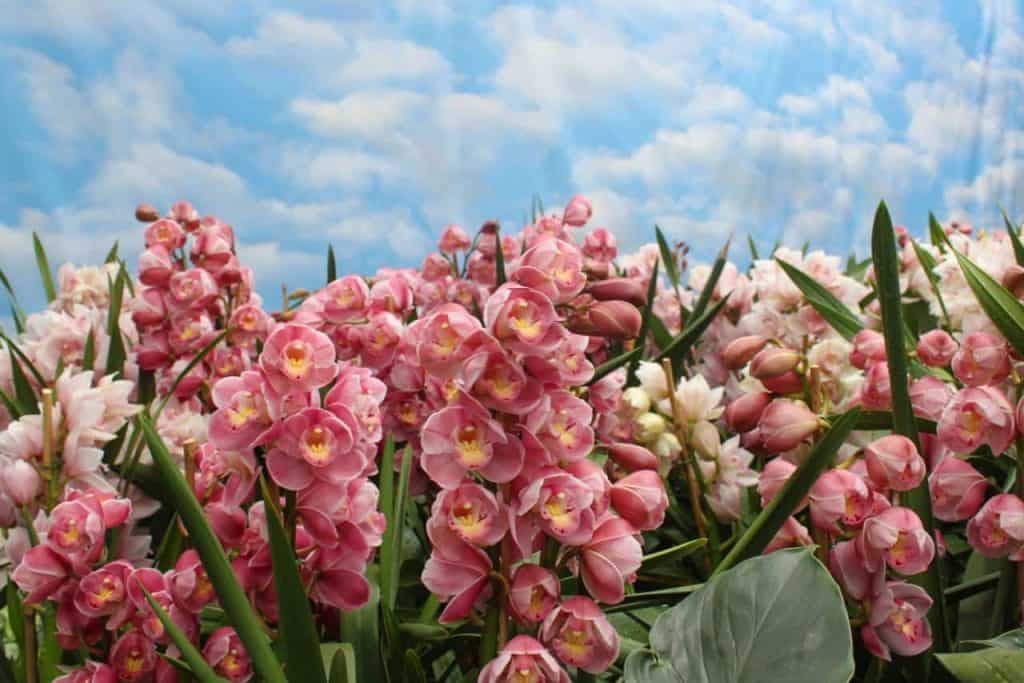Cymbidium Orchid Care: The Basics
Cymbidium orchid (sym-BID-ee-um) is often used in cut flower displays as well as in corsages.
Cymbidium orchids are often called “boat orchids” and the flowers are usually large in size and display a patterned lip. The flowers can last anywhere from 8-10 weeks and they come in almost all colors except blue.
Cymbidium spikes bloom only one time, so once the blooms have dropped you will not be able to encourage a rebloom from the spike as you can with other types of orchids.
They typically bloom in the early spring although sometimes you can see flowers beginning to bloom in October or bloom all the way until June.
Cymbidium orchids are popular due to their ability to thrive in cooler, drier conditions. If you live in an area with mild temperatures and no frost, you may be able to successfully grow Cymbidium orchids outside.
Water Requirements
A Cymbidium orchid should be watered in the morning using tepid water. This will give the orchid adequate time to dry before the lower night temperature sets in.
While the orchid is in active growth, it is recommended that you keep the orchid in slightly damp conditions but never let the medium become soggy.
Watering frequency – as covered in this article about watering orchids – can be determined by a few different things. You will want to water more frequently during the warmer months, at least once a week, and less frequently in the cooler months.
Once the pseudobulbs have finished growing, in the late summer, you can reduce your watering schedule although it is important to not let the orchid dry out completely.
Light Requirements
As covered in this article about orchids care and light, Cymbidiums need medium to bright light intensity in order to thrive, and do best with as much light as possible.
If your Cymbidium orchid is receiving the optimal amount of light the leaves will be a yellow-green color. Too much light will cause the leaves to become yellow, and too little light will cause the leaves to become a very dark green color.
The best place to grow your Cymbidium orchid indoors in on an east facing windowsill, although a shaded south facing window will also work.
If you choose to grow your orchid outside it is important that you give your Cymbidium shelter from direct sun although not in a completely shaded area.
Temperature Requirements
As discussed in this orchid plant care article on temperature, during the summer and fall, day temperatures should be between 75°F to 85°F (23.9°C to 29.4°C), and night temperatures should be between 50°F to 60°F (10°C to 15.6°C).
In order to initiate the growth of flower spikes it is necessary to have a nighttime temperature difference of about 20 degrees in the fall.
Cooler night temperatures are also needed while the plant is in bud. During the winter, day temperatures should be between 65°F to 75°F (18.3°C to 23.9°) and night temperatures should be between 45°F to 55°F (7.2°C to 12.8°C).
Humidity Requirements
As covered in this “humidity” article on how to care for orchids, Cymbidium orchids require humidity levels of 40-60 percent in the winter when the orchid may be in bud.
If you need to increase the humidity level in your orchids growing environment you can do so by using a specially made humidity tray or simply placing a humidifier close by the orchid.
Remember, if you have high humidity levels it is equally important to maintain proper air movement to prevent orchid disease.
Fertilizer Requirements
When the Cymbidium is in active growth, you will want to fertilize regularly. An orchid fertilizer solution of (20-20-20) is recommended.
During the winter months, applying fertilizer once a month is sufficient. It is important to remember to never add fertilizer to an orchid that is dry because you can cause severe damage to the roots and leaves.
Potting Requirements
Cymbidium orchids should be repotted in a course mix every two years or once the potting medium remains soggy and no longer drains properly.
You will want to repot during the spring after the orchids flowers have bloomed. Before repotting, you should trim away the damaged roots with a sterile cutting tool.
The best type of pot to use for a Cymbidium orchid is a clay pot. This is because water evaporates from clay pots faster and this is better for the dryer conditions that Cymbidiums require.
Cymbidiums can be divided once the orchid has bloomed and new growth is starting to show. Each division needs at least three to five pseudobulbs.
Another way to propagate a Cymbidium is to use the backbulbs which are the older pseudobulbs that have little to no leaves.
Simply remove these with a sterile cutting tool and strip off any leaves that may still be on the backbulb and pot in a small container.
You will need to keep the backbulbs moist and place in an area that is fairly shady. You should begin to see new growth and roots appear in only a few short months, and in as little as two to three years, a backbulb can grow into a full sized plant.
And that just about covers the basics! 🙂
Originally posted 2021-04-30 20:29:36.



